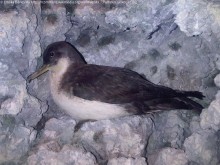600th species added to the British List
18 February 2016
Yelkouan Shearwater is the 600th bird species to be admitted to the British List
The British Ornithologists’ Records Committee (BOURC) is delighted to announce the addition of the 600th species to the British List.
Yelkouan Shearwater Puffinus yelkouan, breeds on islands and coastal cliffs in the Mediterranean Sea (primarily the east). Whilst the majority of the Yelkouan Shearwaters population moves east outside the breeding season to winter in the Black Sea, small numbers (presumably of the western most breeding birds) are known to move west and enter the North Atlantic to find food during the summer and autumn after breeding.
Yelkouan Shearwater seen off Berry Head, Devon, 29 July 2008
This individual, the first positively identified in British waters, was discovered by Mike Langman and Mark Darlaston while surveying for a similar species, Balearic Shearwater Puffinus mauretanicus. Balearic Shearwaters also breed within the Mediterranean Sea, but as their name suggests breed primarily around the Balearic islands and western sea area) and move in to the North Atlantic in summer. They are seen around the shores of the UK and Ireland every year, with largest numbers in the south-west of England and off southern Ireland. Thus the observation of this Yelkouan Shearwater accords with the known pattern of movement of a shearwater species with a similar range.
Yelkouan and Balearic shearwaters are very close in appearance, so it was fortunate that the observers had much experience of the two species, and both species were present on the day to allow direct comparison, photograph and confirm the identification.
We were delighted to hear the Yelkouan Shearwater seen at Berry Head, Devon on 29 July 2008 had finally been accepted as the first for Britain. What has made this even more special was the realisation it was the 600th species for the British list – a truly remarkable milestone and we’re sure neither of us will be here when 700th is added! The identification of the species is far from straightforward and we commend BOURC and BBRC for the thorough process the record went through before arriving at a final decision. We were lucky on the day to see the bird well at fairly close range for a prolonged period (in a seawatching context), in the company of a Balearic Shearwater off the headland. Undoubtedly the photographs we both managed to secure at the time helped the evaluation process together with some detailed observation notes made on the spot.
Mike Langman and Mark DarlastonIt is a testament to over 200 years’ enthusiasm and perseverance of British birders and ornithologists that the national bird list of a small, northern temperate country has reached 600 species. It is also satisfying that this milestone has been reached via an exemplary process of sharp birding, detailed fieldnotes, photographs and research. Yelkouan Shearwater is a fascinating species, and it was both a pleasure and a challenge for the Records Committee to review the identification, migration patterns and vagrancy potential of this species, and its relationship with the critically endangered (and very variable) Balearic Shearwater.
This record also demonstrates the strong links between the two national committees we have overseeing records of rare birds occurring in the UK. Although it is the role of the BOURC alone to add (or remove) species from the British List, the British Birds Rarities Committee (BBRC) plays an important role in this process, particularly on the more challenging taxa such as here.
Martin Collinson, Chairman BOURCAfter several claims and false starts, this enigmatic seabird has finally earned its place on the British List. Like Scopoli’s Shearwater Calonectris diomedea, this species was going to require an exceptionally well seen and described bird to be acceptable, and we believe this record has made the grade in all areas. The submission was well supported by detailed notes from well-respected and experienced observers, backed up by photographs that showed all of the requisite features. All of this made the assessment surprisingly straightforward, and the committee accepted it unanimously in a single circulation.
Paul French, Chairman BBRC
View full British List
BOURC reports and papers
More about the British List
British Birds Rarities Committee (BBRC)
Image Credit: © Emőke Dénes via WikiMedia Commons

